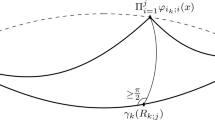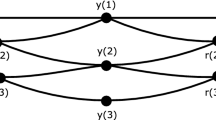Abstract
For a compact connected Lie group G acting as isometries of cohomogeneity not equal to 0 or 2 on a compact orientable Riemannian manifold \(M^{n+1},\) we prove the existence of a nontrivial embedded G-invariant minimal hypersurface, that is smooth outside a set of Hausdorff dimension at most \(n-7.\)
Similar content being viewed by others
References
Allard, W.K.: First variation of a varifold. Ann. Math. Second Ser. 95(3), 417–491 (1972)
Almgren Jr., F.J.: The homotopy groups of the integral cycle groups. Topology 1, 257–299 (1962)
Brendon, G.: Introduction to Compact Transformation Groups, 1st edn. Academic Press, (1972)
Colding, T.H., De Lellis, C.: The min–max construction of minimal surfaces. Surv. Differ. Geom. VII I, 75–107 (2003)
De Lellis, C.: Dominik Tasnady the existence of embedded minimal hypersurfaces. J. Differ. Geom. 95(3), 355–388 (2013)
Federer, H.: Geometric Measure Theory. Springer, New York (1969)
Federer, H.: The singular sets of area minimizing rectifiable currents with codimension one and of area minimizing flat chains modulo two with arbitrary codimension. Bull. Am. Math. Soc. 76, 767–771 (1970)
Gray, A.: Tubes. Springer, New York (2004)
Heisey, R.: Partitions of unity and a closed embedding theorem for \((C^{p}, b)\)-manifold. Trans. Am. Math. Soc. 206, 281–294 (1975)
Hsiang, W., Lawson Jr., H.B.: Minimal submanifolds of low cohomogeneity. J. Differ. Geom. 5, 1–2 (1971)
Ketover, D.: Equivariant Min–Max Theory, preprint at arXiv:1612.08692
Lange, C.: On the existence of closed geodesics on 2-orbifolds. Pac. J. Math. 294(2), 453–472 (2018)
Lawson Jr., H.B.: The equivariant plateau problem and interior regularity. Trans. Am. Math. Soc. 173, 231–249 (1972)
Lee, J.: Introduction to Smooth Manifold, 2nd edn. Springer, New York (2003)
Moore, J.D., Schlafly, R.: On equivariant isometric embeddings. Math. Z. 173, 119-i33 (1980)
Mostert, P.S.: On a compact lie group acting on a manifold. Ann. Math. Second Ser. 65(3), 447–455 (1957)
Marques, F.C., Neves, A.: Morse index of multiplicity one min–max minimal hypersurfaces. arXiv:1803.04273 [math] (2018)
Pacini, T.: Mean curvature flow, orbits, moment maps. Trans. Am. Math. Soc. 355(8), 3343–3357 (2003)
Pitts, J.T., Rubinstein, J.H.: Equivariant minimax and minimal surfaces in geometric three-manifolds. Bull. Am. Math. Soc. (NS) 19(1), 303–309 (1988)
Pitts, J.T., Rubinstein, J.H.: Applications of minimax to minimal surfaces and the topology of 3-manifolds. Miniconference on geometry and partial differential equations, 2 (Canberra, 1986), 137–170, Proc. Centre Math. Anal. Austral. Nat. Univ., 12, Austral. Nat. Univ., Canberra (1987)
Schoen, R., Simon, L.: Regularity of stable minimal hypersurfaces. Comm. Pure Appl. Math. 34(6), 741–797 (1981)
Wall, C.T.C.: Differential Topology. Cambridge University Press, Cambridge (2016)
Wasserman, A.: Equivariant differential topology. Topology 8(2), 127–150 (1969)
White, B.: The maximum principle for minimal varieties of arbitrary codimension. Commun. Anal. Geom. 18(3), 421–432 (2010)
Wickramasekera, N.: A sharp strong maximum principle and a sharp unique continuation theorem for singular minimal hypersurfaces. Calc. Var. Partial Differ. Equ. 51(3–4), 799–812 (2014)
Acknowledgements
The author is very fortunate to have been introduced to the world of geometric measure theory by Professor William Allard, who has read the very first draft of this paper and given invaluable suggestions. The author cannot thank him enough for many stimulating and revelatory conversations about GMT. Also, the author would like to thank Professor Robert Bryant for countless helpful discussions on Lie groups, transformation group theory and Riemannian geometry, and his unwavering support. Indeed, this paper originates from a conversation about invariant cycles in Lie groups with Professor Bryant. The author also thanks Professor Hubert Bray for many helpful meetings and constant encouragement. He would like to thank Professor Camillo De Lellis and Fernando Codá Marques for their interest in this work and pointing out the reference [11]. The author also would like to thank the referee for countless helpful advice on both the structure of the paper and the writing of some proofs, which improves the readability of the paper by a large margin. A special thanks goes to Antoine Song for pointing out that the regularity argument does not work for cohomogeneity 2 case. Last but not least, he is indebted to Professor David Kraines, who partially funded the research in the paper with PRUV Fellowship.
Author information
Authors and Affiliations
Corresponding author
Additional information
Communicated by C. De Lellis.
Dedicated to Xunjing Wei.
Publisher's Note
Springer Nature remains neutral with regard to jurisdictional claims in published maps and institutional affiliations.
Appendix A. Appendix
Appendix A. Appendix
1.1 A.1. Ball covering of tubes
We will prove the following useful lemma.
Lemma A.1
For any \(y\in M,\) there exists \(\rho _0>0\) so that for any \(\rho <\rho _0,\) there exists a collection \({\mathcal {B}}\) of disjoint geodesic balls of radius \(\rho \) with centers in G.y so that the concentric balls with radius \(5\rho \) covers \(B^G_\rho (y)\). Moreover, the number of balls in this collection is at most \(C_y \rho ^{-d_y},\) where \(C_y\) is a constant depending only on G.y, and \(d_y=\dim G.y.\)
Proof
Here we use a basic 5-times-radius covering theorem (putting \(\tau =2\) and \(\delta \) as diameter in 2.8.5 in [6]), that says for a covering using metric balls in metric space, we can find a disjoint subcollection so that 5-times-radius concentric balls of this subcollection would cover all the original balls. Now consider the covering of \(B_{\rho }^G(y)\) by \(\{B_{\rho }(z)|z\in G.y\}.\) We deduce that there exists a set \({\mathcal {B}}\) consisting of finitely many points so that \(B_{\rho }(z)\cap B_{\rho }(z')=\varnothing \) if \(z\not =z',z,z'\in {\mathcal {B}}\) and
Note that the cardinality of \({\mathcal {B}}\) satisfies the following obvious bound
since G acts by isometries and thus pushes forward geodesic balls to geodesic balls.
Let
Recall the volume of tubes in [8]. There exists \(\rho _0>0\) so that for all \(\rho <\rho _0\), we would have
for some dimensional constant \(C_{d_y}>0.\) Moreover, by the volume of geodesic balls, we could assume that \( \text {Vol}(B_{\rho }(y))\ge C_{n}\rho ^{n+1}, \) for some dimensional constant \(C_n>0\) by shrinking \(\rho _0\) if necessary. If \(\rho <\rho _0,\) then there exists \(C_y>0\) depending only on G.y and M such that
\(\square \)
1.2 Splitting of tangent cone of integral G-varifold
Let G.x be an orbit of dimension \(d_x\), and \(B_\rho ^G(x)\) be the \(\rho \)-tubular neighborhood around x. Suppose V is a rectifiable G-varifold in \({\mathbf {V}}_n\) and x is in \(\text {spt}V\). We will prove the following lemma which implies that the tangent cone splits as a product into normal directions and tangential directions to G.x.
Lemma A.2
For any point \(y\in G.x,\) there exists a tangent cone \(C_y\subset T_y M\) of V, so that \(C_y+w=C_y\) for any \(w\in T_y G.x\subset T_y M.\)
Proof
Without loss of generality, we can assume \(y=x,\) since we can always pushforward our constructions by any element of g. We will use \(\exp \) to denote the restriction of exponential map in \(T_yM\) inside a ball of injectivity radius. Let \(r_i\rightarrow \infty \) be a sequence so that \((r_i )_{\#}\exp ^{-1}_{\#}(V)\rightarrow C\) as varifold, where \(r_i\) is multiplication by \(r_i\) in \(T_yM.\) Note that we have
if i is the inclusion \(G.y\hookrightarrow M.\)
By Main Theorem of [15], we can isometrically embed M into some \({\mathbb {R}}^N\) so that the action of G on M comes from a linear representation of G on \({\mathbb {R}}^N.\) We will also denote this action as \(\rho (g)z\) for \(z\in {\mathbb {R}}^N.\) We will identify M as a submanifold of \({\mathbb {R}}^N\) in the following reasoning.
Let \(c\in C_y\) be a point in the tangent cone. We will also regard it as a vector. We can find a sequence of points \(c_j\in V\) so that \(r_j\exp _{\#}^{-1}c_j\rightarrow c.\) Let g(t) be a smooth path in G so that \(g(0)=0\),
Such a path exists by lifting a corresponding path starting with \(w\in T_y G.y\) and staying in \(G.y\approx G/G_y\).
Now, note that \(g(r_i^{-1}).c_i\in V.\) If we can prove that
then we are done. To prove this, we need to compare \(\exp _{\#}^{-1}(z)\) with \(z-y\). First, note that \(d(z-y)|_{T_y{\mathbb {R}}^N}=\text {id}_{T_y{\mathbb {R}}^N}=d\exp _{\#}^{-1}(z)|_{T_y{\mathbb {R}}^N}.\) Thus, \(\exp _{\#}^{-1}(z)-(z-y)=O(d_M(z,y)^2)\) for \(z\in M.\). Thus, we have
Let \(i\rightarrow \infty \), and we immediately get A.2. \(\square \)
Corollary 3
The support of any such cone \(C_y\) as in A.2 is a product of \(T_yG.x\) and a rectifiable set W supported in \(i_{\#}(T_yG.x)^\perp .\)
Proof
Take \(W=C_y\cap i_{\#}(T_yG.x)^\perp \) and use Lemma A.2. \(\square \)
Rights and permissions
About this article
Cite this article
Liu, Z. The existence of embedded G-invariant minimal hypersurface. Calc. Var. 60, 36 (2021). https://doi.org/10.1007/s00526-020-01804-7
Received:
Accepted:
Published:
DOI: https://doi.org/10.1007/s00526-020-01804-7




